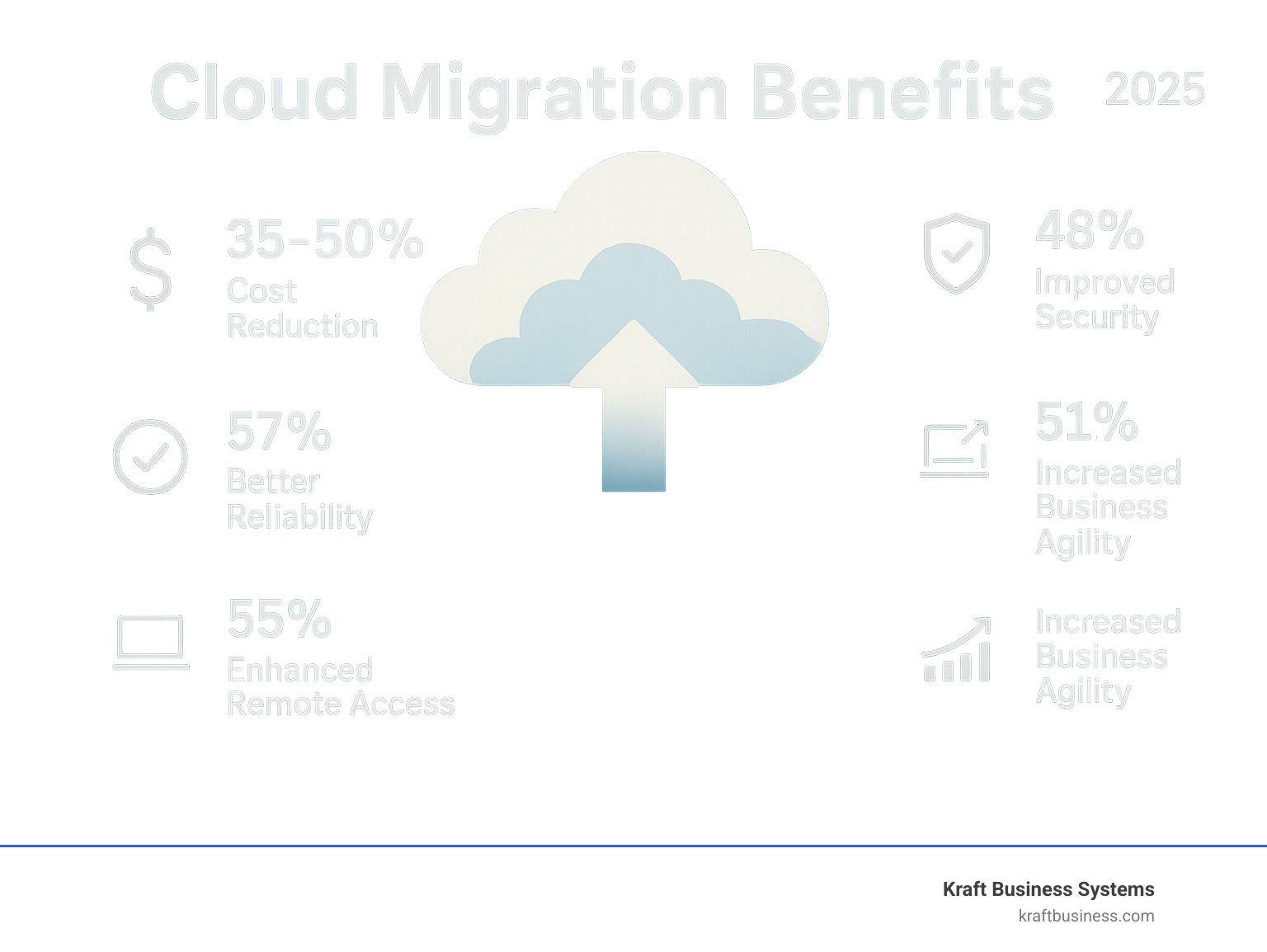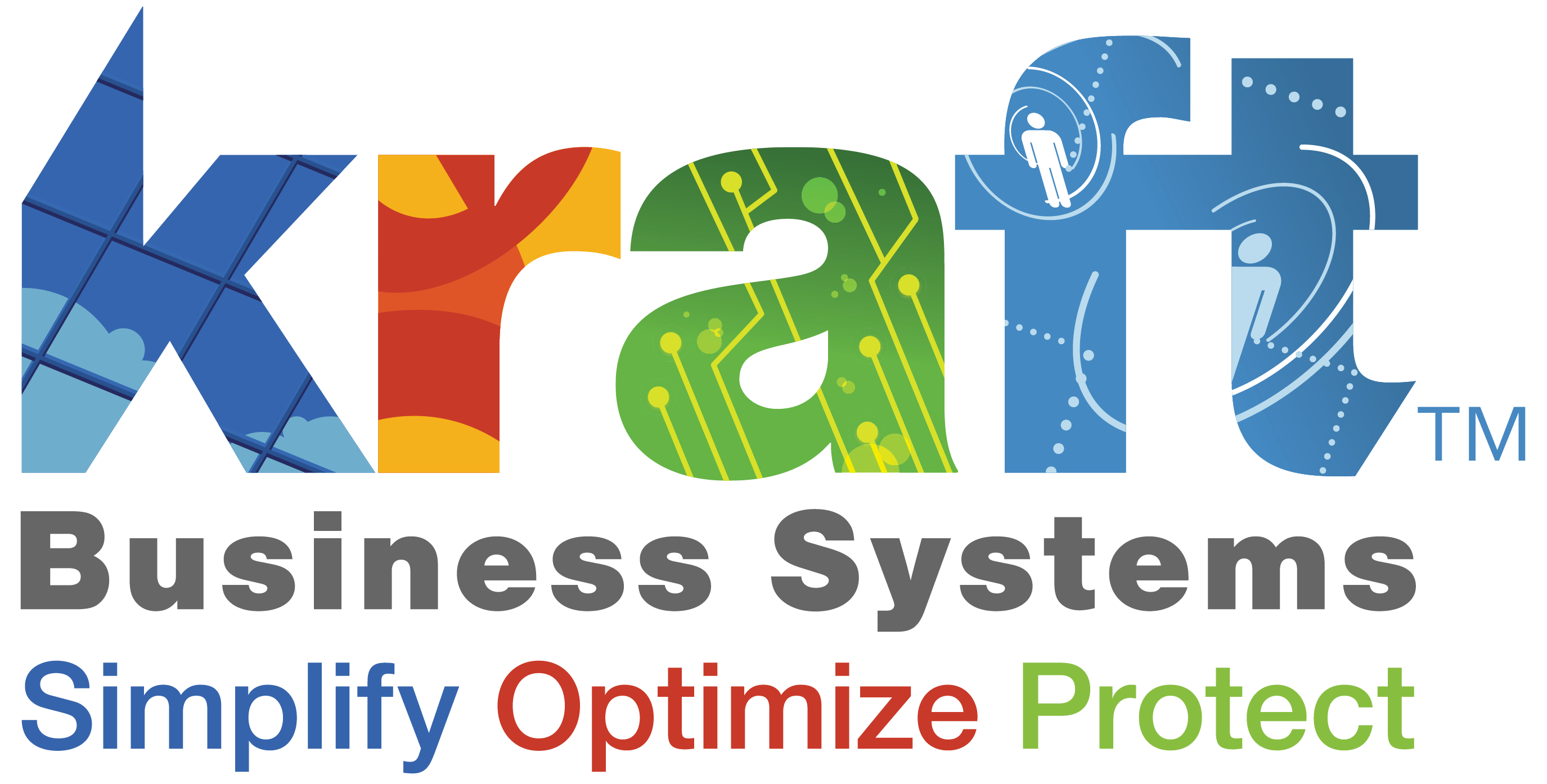Cloud migration for businesses has transformed from a trendy tech upgrade to a strategic necessity. With 45% of organizations already shifting at least half of their applications to public clouds, the question isn’t whether to migrate—it’s how to do it right.
Key Benefits of Cloud Migration:
- Cost Reduction: 35-50% lower costs compared to on-premise solutions
- Improved Security: 48% of businesses report better security in the cloud
- Improved Reliability: 57% cite improved recovery capabilities
- Remote Accessibility: 55% report better data access for remote users
- Business Agility: 51% see improved overall efficiency
The shift from traditional on-premise data centers to cloud infrastructure isn’t just about technology—it’s about business survival. Modern businesses need the flexibility to scale resources instantly, the security to protect against evolving threats, and the agility to respond to market changes faster than ever.
As one respondent in recent research noted, moving internal processes to the cloud met expectations despite initial setup challenges, with their provider working through issues to deliver the promised scalability and cost efficiency.
By 2027, industry projections show that most organizations will maintain at least three-quarters of their applications on public clouds. The cloud migration train has left the station—and businesses that don’t board risk being left behind with inflexible, costly infrastructure that can’t keep pace with digital demands.
Cloud migration for businesses terms you need:
Why Move to the Cloud? Unpacking the Core Benefits
The cloud isn’t just a shiny new technology trend—it’s a complete game-changer for how businesses operate. When we talk about cloud migration for businesses, we’re really talking about open uping a whole new level of what’s possible. From startups to established enterprises, organizations are finding that the cloud delivers tangible benefits that touch every corner of their operations.
The beauty of cloud computing lies in its ability to transform rigid, expensive IT infrastructure into something flexible, secure, and surprisingly cost-effective. We’re talking about scalability that lets you grow without limits, improved security that rivals enterprise-grade protection, improved reliability that keeps your business running 24/7, and disaster recovery capabilities that used to cost a fortune.
But perhaps most importantly, the cloud enables business agility—the ability to pivot quickly when markets change, launch new products faster, and support remote teams seamlessly. It’s about creating an environment where innovation thrives and your business can respond to opportunities at the speed of thought, not the speed of hardware procurement.
Boost Your Agility and Scalability
Picture this: your website suddenly goes viral, traffic spikes 1000%, and instead of crashing, your systems automatically scale up to handle the load. That’s the magic of cloud scalability and flexibility in action.
The pay-as-you-go model is perhaps the most aspect of cloud computing. Gone are the days of buying expensive servers that sit idle 80% of the time “just in case.” With cloud resource scaling, you can spin up additional computing power in minutes, not months. This faster deployment capability means you can test new ideas, launch products, and respond to market opportunities with unprecedented speed.
This flexibility has been a lifesaver for remote workforce enablement. When the world shifted to remote work almost overnight, businesses with cloud infrastructure adapted seamlessly. In fact, 55% of organizations report improved remote access to data and applications after migrating to the cloud. Your team can collaborate effectively whether they’re in the office, at home, or halfway around the world.
The cloud innovate faster and offers flexible resources that traditional on-premise setups simply can’t match. Market responsiveness becomes your competitive advantage when you can launch new services in days instead of months.
Strengthen Security and Ensure Compliance
Let’s tackle the elephant in the room: many business owners worry that moving to the cloud means giving up control over security. The reality? Cloud security is often far superior to what most businesses can achieve on their own.
Cloud providers operate on a shared responsibility model—they handle the security of the underlying infrastructure while you maintain control over your data and applications. This partnership gives you access to enterprise-grade security measures, including proactive threat detection, advanced encryption, and automated patching that happens behind the scenes.
The numbers speak for themselves: 48% of businesses report better security after moving to the cloud. That’s because cloud providers invest millions in security infrastructure, threat intelligence, and round-the-clock monitoring—resources that would be prohibitively expensive for individual businesses.
For companies in regulated industries, cloud platforms simplify compliance standards dramatically. Whether you need SOC-2 certification for handling customer data or FedRAMP approval for government work, major cloud providers have already done the heavy lifting. This built-in compliance framework can save months of work and thousands in consulting fees.
If cybersecurity is keeping you up at night, our managed cybersecurity services can help you steer both cloud and on-premise security challenges with confidence.
Optimize IT Costs and Performance
Here’s where cloud migration gets really exciting for business owners: the potential for dramatic cost savings combined with better performance.
The shift from CapEx to OpEx fundamentally changes how you think about IT spending. Instead of massive upfront investments in hardware that depreciates rapidly, you pay for what you actually use. Studies consistently show 35-50% cost reductions compared to traditional on-premise setups when you factor in reduced hardware costs, lower maintenance overhead, and eliminated upgrade cycles.
But cost savings are just part of the story. Cloud providers maintain global data centers strategically located around the world, which means reduced latency and faster response times for your applications. Your customers in California and customers in New York can both enjoy lightning-fast performance because your applications are running from data centers optimized for their locations.
The reliability improvements are equally impressive. 57% of businesses cite improved reliability as a major cloud benefit. This improved stability translates directly into increased productivity—when your systems are always available and performing optimally, your team can focus on growing the business instead of troubleshooting IT issues.
Perhaps most importantly, cloud migration enables sustainability initiatives. Cloud data centers are significantly more energy-efficient than traditional server rooms, helping reduce your carbon footprint while improving performance.
The Strategic Blueprint for Cloud Migration for Businesses
Planning your cloud migration for businesses is like orchestrating a complex symphony – every piece needs to work in harmony to create something beautiful. You wouldn’t move your family to a new city without carefully planning the logistics, and the same thoughtful approach applies to moving your business operations to the cloud. This strategic journey requires extensive planning and careful execution, typically following a phased approach that minimizes disruption while maximizing your chances of success.
The beauty of cloud migration lies in its flexibility – there’s no single “right” way to do it. Your approach will depend on your current infrastructure, business goals, timeline, and tolerance for complexity. Some organizations prefer a gradual transition, moving applications piece by piece, while others opt for a more aggressive timeline. The key is finding the strategy that aligns with your unique situation.
The 6 Common Cloud Migration Strategies (The “6 R’s”)
When we sit down with businesses to plan their cloud journey, we often discuss what the industry calls the “6 R’s” – six distinct strategies that each offer different levels of complexity, cost, and potential benefits. Think of these as different approaches to renovating your home: some involve simple cosmetic changes, while others require tearing down walls and rebuilding from scratch.
Rehosting (Lift and Shift) is often where businesses start their cloud journey. This approach involves taking your existing applications and moving them to the cloud with minimal changes – imagine picking up your entire office and placing it in a new building without rearranging the furniture. It’s the fastest way to get cloud benefits like improved reliability and reduced hardware costs, making it perfect for organizations that need quick wins or are just getting comfortable with cloud environments.
Replatforming (Lift and Optimize) takes things a step further by making targeted improvements during the move. You might migrate your database to a managed cloud service or update your application to use cloud-specific features. It’s like moving to that new office but upgrading to better furniture and modern lighting – you get more benefits without a complete overhaul.
For organizations ready to fully accept cloud-native capabilities, Refactoring (Re-architecting) involves rebuilding applications from the ground up. This might mean breaking down large, monolithic applications into smaller microservices or adopting serverless computing. While this approach requires significant time and expertise, it open ups the full potential of cloud scalability and resilience.
Sometimes the smartest move is Repurchasing (Drop and Shop) – simply replacing existing applications with cloud-native alternatives. Instead of migrating your old email system, you might switch to a modern cloud-based solution. This approach can be surprisingly quick and often provides immediate access to advanced features your old system couldn’t offer.
The Retiring strategy recognizes that not everything deserves a spot in your new cloud environment. During assessment, you might find applications that nobody uses anymore or systems that have been replaced but never properly decommissioned. Why spend time and money migrating something that adds no value?
Finally, Retaining acknowledges that some applications should stay put, at least for now. Maybe you’ve recently invested heavily in on-premises infrastructure, or certain systems have strict regulatory requirements that make cloud migration challenging. This often becomes part of a hybrid approach, giving you time to plan future moves.
Key steps in a successful cloud migration for businesses
Every successful cloud migration for businesses follows a similar roadmap, though the specific details vary based on your chosen strategies and unique requirements. We’ve found that breaking the process into clear, manageable steps helps organizations stay on track and avoid common pitfalls.
Step 1: Assess Current Infrastructure forms the foundation of everything that follows. Before moving anything, we need to understand exactly what you have – every application, database, server, and network connection. This comprehensive inventory reveals hidden dependencies that could cause problems later. We also evaluate performance requirements, security considerations, and compliance needs. It’s detective work that pays dividends throughout the migration process.
Step 2: Develop a Detailed Migration Plan transforms your assessment findings into actionable strategy. This blueprint outlines specific goals for each application, chosen migration strategies, realistic timelines, and clear responsibilities for everyone involved. We also create thorough testing procedures and rollback plans – because even the best-laid plans sometimes need adjustments.
Step 3: Prepare the Cloud Environment involves building your new digital foundation. We configure virtual networks, set up storage systems, implement security policies, and ensure everything is ready to receive your applications and data. This preparation phase is crucial for creating a secure, optimized environment that supports your business needs.
Step 4: Migrate Applications and Data in Waves represents the heart of the migration process. Rather than attempting to move everything at once – which would be like trying to relocate your entire company over a weekend – we migrate in carefully planned stages. Each wave includes a manageable batch of applications and data, followed by thorough testing and optimization. This iterative approach minimizes downtime and allows us to apply lessons learned from each wave to subsequent migrations.
Step 5: Optimize and Monitor Post-Migration ensures your investment continues paying dividends long after the initial move. We continuously monitor application performance, track cloud usage and costs, and fine-tune configurations as needed. This ongoing optimization phase often reveals opportunities to modernize applications further and truly harness cloud-native capabilities.
Comparing Migration Types
Understanding the different types of cloud migration for businesses helps you set realistic expectations and choose the right approach for your organization. Each type has its own scope, complexity, and strategic purpose.
| Feature | Full Data Center Migration | Hybrid Cloud Migration | Cloud-to-Cloud Migration |
|---|---|---|---|
| Scope | All IT assets move to the cloud | Some assets in cloud, some on-premise | Assets move between cloud providers |
| Goal | Eliminate on-premise footprint | Leverage best of both worlds | Optimize cost, features, or performance |
| Complexity | High | Moderate to High | Varies |
Full Data Center Migration represents the most ambitious approach, aiming to completely eliminate your physical data center footprint. This comprehensive strategy moves all IT infrastructure, applications, and data to the cloud, dramatically reducing maintenance overhead and capital expenses. While complex, this approach offers the greatest long-term benefits for organizations ready to fully accept cloud-first operations.
Hybrid Cloud Migration offers a balanced approach that many organizations find appealing. By moving some applications to the cloud while keeping others on-premises, you can maintain control over sensitive data or legacy systems while still gaining cloud benefits like scalability and flexibility for other workloads. This model works particularly well for businesses with strict compliance requirements or significant recent investments in on-premises infrastructure.
Cloud-to-Cloud Migration addresses the evolving needs of organizations already in the cloud. You might move between providers to access better pricing, specialized features, improved performance, or simply to avoid vendor lock-in. While the technical complexity varies depending on your specific situation, these migrations often focus on optimization rather than fundamental infrastructure changes.
While the benefits of cloud migration for businesses are compelling, the journey isn’t without its bumps. We’ve seen businesses encounter a range of common challenges, from technical complexities to cost surprises and even resistance from within their own teams. Understanding these potential pitfalls is the first step toward effectively mitigating them. As one industry expert, Matthew Keeler, CEO of The KR Group, aptly puts it, “Cloud security is no longer optional—it’s a fundamental business necessity to protect sensitive data and ensure operational continuity.”
Overcoming Technical Problems and Minimizing Downtime
Technical complexity is a major hurdle. Applications often have intricate dependencies, and older systems may not be directly compatible with cloud environments. This can lead to issues with data integrity during transfer and potential application downtime. In fact, 41% of organizations cited the “inflexibility of on-premises data centers” as a challenge, highlighting the technical debt that can complicate migration.
To minimize these risks, we always advocate for a phased migration approach, as discussed earlier. Moving workloads in waves allows us to thoroughly test each segment before proceeding. Rigorous testing, including performance and security validations, is crucial. We also ensure comprehensive rollback plans are in place, so that in the unlikely event of an issue, we can quickly revert to the previous state, ensuring business continuity. This meticulous approach helps us avoid the pitfalls of migrating everything at once, which can lead to significant disruptions.
Managing Costs and Avoiding Vendor Lock-in
While cost optimization is a primary driver for cloud migration, unexpected expenses can quickly turn a dream into a nightmare. Hidden costs, such as data egress fees (charges for moving data out of the cloud), and underestimating storage or outgoing traffic can lead to budget overruns. Half of businesses with fewer than 1,000 employees cited cost as a constraining factor, and 44% of them struggled with “limited capacity for data storage,” indicating that cost management is a universal concern.
Effective cost management strategies are vital. This involves continuous monitoring of cloud resource usage, rightsizing instances to match actual needs, and leveraging reserved instances or spot instances where appropriate. We focus on optimizing your cloud environment post-migration to ensure you’re only paying for what you truly need.
Another significant risk is vendor lock-in, where businesses become overly dependent on a single cloud provider, making it difficult or costly to switch later. To mitigate this, we explore multi-cloud strategies or hybrid cloud architectures that provide greater flexibility. Using cloud-agnostic tools and open-source solutions can help maintain portability and prevent deep integration into proprietary services, giving you more control over your digital future. For more comprehensive IT solutions, consider our offerings at Kraft Business Systems IT solutions.
Preparing Your Team and Culture for the Cloud
Technology changes faster than people often do. Cloud migration for businesses is not just an IT project; it’s an organizational change that impacts processes, roles, and skills. The digital skills gap is a real concern, and employee hesitancy or resistance to new tools and processes can hinder adoption. While IT professionals will find most of their current skills apply, skills training is still needed. Upfront cloud skill-building and training can set up organizations for success during and after migration.
We help businesses prepare their workforce by investing in upfront cloud skill-building and training. This includes not just technical skills for IT teams, but also fostering a cloud-native mindset across the organization. Encouraging continuous learning, establishing clear communication channels about the benefits of the migration, and involving key stakeholders from the outset can help smooth the transition. It’s about empowering your team with the knowledge and confidence to accept the new cloud environment, turning potential resistance into enthusiastic adoption.
Frequently Asked Questions about Cloud Migration
When we talk with businesses about cloud migration for businesses, we hear the same thoughtful questions over and over. These conversations help us understand what really matters to business owners and IT teams as they consider this important step. Let’s explore the questions that come up most often.
What is the most significant benefit of cloud migration for a small business?
For small businesses, the game-changer is usually the financial flexibility that comes with cloud migration. Think about it this way: instead of writing a big check upfront for servers and hardware (what we call Capital Expenditures), you switch to a pay-as-you-go model where you only pay for what you actually use (Operational Expenditures).
This shift is particularly powerful for smaller organizations because it means you can scale your IT resources up or down based on your actual needs, without betting the farm on expensive equipment that might sit unused. A growing business in Grand Rapids, for example, can handle seasonal spikes in demand without investing in infrastructure they’ll only need a few months of the year.
The increased agility this brings is what really levels the playing field. Small businesses can now compete with much larger organizations because they have access to the same enterprise-level technology, just sized to their needs and budget.
How do you measure the success of a cloud migration?
Success isn’t just about getting everything moved to the cloud—it’s about achieving the specific goals you set out to accomplish when you started the journey. We always begin by establishing clear benchmarks during the planning phase, then measure against those targets.
The most common metrics we track include Total Cost of Ownership (TCO) reduction—comparing your actual cloud spending to what you were paying for on-premises infrastructure. We also look at performance improvements like faster application response times and better uptime statistics.
Security improvements are another key indicator. This might mean fewer security incidents, faster patch deployment, or better compliance audit results. For development teams, we often measure increased productivity—how much faster can they deploy new features or applications?
The real success story isn’t just in the numbers, though. It’s when business owners tell us they can finally focus on growing their business instead of worrying about whether their servers will crash over the weekend.
What are the latest trends impacting cloud migration for businesses?
Two major trends are reshaping how businesses approach cloud migration, and both are pretty exciting.
First, AI integration is becoming a huge driver for cloud adoption. Recent industry research shows that two-thirds of organizations are now using AI, with at least 48% of those running their AI workloads on cloud platforms. The cloud provides the massive computing power and specialized services that make AI and machine learning accessible to businesses of all sizes—not just tech giants.
The second trend is sustainability. More businesses are realizing that cloud providers’ massive, optimized data centers are often much more energy-efficient than traditional on-premises setups. By migrating to the cloud, companies can significantly reduce their carbon footprint while still improving performance.
This sustainability angle is particularly important for businesses that want to align their technology decisions with environmental responsibility goals. It’s a win-win: better performance and lower environmental impact.
These trends show that cloud migration for businesses isn’t just about moving data anymore—it’s about positioning your organization for the future of work, innovation, and responsible business practices.
Your Partner in a Seamless Cloud Journey
A successful cloud migration for businesses is not just a technical shift—it’s a strategic business change that open ups new levels of efficiency, security, and innovation. When you understand the benefits, choose the right migration strategy, and proactively address challenges, your organization can steer this transition smoothly and start reaping the rewards almost immediately.
Think of cloud migration like renovating your home while you’re still living in it. You need experienced contractors who know how to minimize disruption, work around your daily routine, and deliver results that exceed your expectations. That’s exactly what we do at Kraft Business Systems.
Located in Grand Rapids, Michigan, we’ve helped businesses across the region—and beyond—transform their IT infrastructure without the headaches typically associated with major technology changes. Our team of consultants and industry experts brings together diverse skills and real-world experience to tackle your unique business challenges.
What sets us apart? We believe that downtime is so last year. While other companies might approach migration as a necessary evil that comes with inevitable disruptions, we’ve refined our process to make transitions as seamless as possible. We’re not just moving your data; we’re aligning technology with your core business objectives.
From that initial assessment where we map out every application and dependency, through the detailed planning phase, all the way to post-migration optimization—we’re with you every step of the way. We’ve seen how the right migration strategy can transform a struggling business into an agile, competitive force in their market.
Our approach is built on partnership, not just service delivery. We take the time to understand your business goals, your team’s capabilities, and your tolerance for change. Then we craft a migration strategy that fits your reality, not some textbook ideal.
Ready to make downtime a thing of the past and open up the full potential of cloud computing for your business? Contact us today to start planning your move to the cloud. Let’s turn your cloud migration from a daunting project into a competitive advantage.










